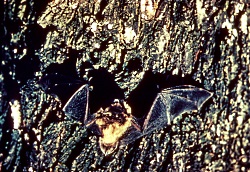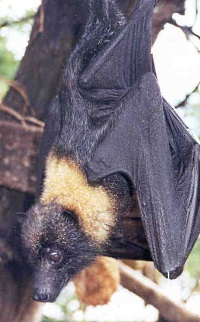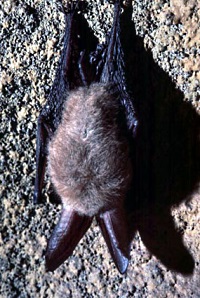
Photographer: W.D. Fritzwater
Courtesy US FWS
Hi, I’m Holly Strand from Stokes Nature Center in beautiful Logan Canyon.
There are approximately 4600 mammal species in the world. A fifth—yes, 20%– of these species are bats. They are found everywhere except Antarctica. In Utah they are found at every elevation and in every ecosystem.
Bats are the only mammal that flies. “You forgot about humans,” my very precise husband points out. Well, OK bats are the only mammal that flies without a license and an airplane.
The majority of bats have smallish eyes perhaps leading to the expression “blind as a bat.” But bats are not at all blind. All of them can see and some rely solely on vision for both navigation and foraging. But most bats also have a sixth sense—called echolocation–to navigate and detect prey.

From the
Northern Mariana Islands
Photographer: Ann Hudgins
Courtesy US FWS
Echolocation refers to the process of sending out pulses of sound and listening to
the echoes to locate or avoid objects. Bats emit pulses of high frequency sound from their larynx or voicebox. These sounds are ultrasonic which means that they occur at frequencies beyond the range that humans can hear. The sounds are emitted through the mouth in some bats and through the nose in others.
The sounds bounce off external objects and echoes are returned to the bat’s ear. The size and shape of the bat’s ears help amplify the returning sound. The sound travels through the ear and is converted to vibrations in the inner ear fluid and then on to the brain via the auditory nerve.
Bat brains have unique structures that compare the features of the original sound pulse against the characteristics of the returning echoes. By assembling and assessing the return data, bats can know the direction of and distance of an object. Some bat species have evolved echolocation to such a degree that they can even distinguish shape among individual species of insects.

Courtesy National Park Service
Because of echolocation bats are phenomenal hunters in low light conditions. A single little brown bat can catch 300 to 3,000 insects per night, and a nursing mother little brown bat eats more than her body weight each night — up to 4,500 insects. Hmm. That’s a lot of mosquitoes. I think I’ll invite some bats to my backyard this summer.
Thanks to the Marie Eccles Foundation –the Russell Family for supporting Stokes Nature Center programs.
For Wild About Utah and Stokes Nature Center, I’m Holly Strand.
Credits:
Images: Courtesy US FWS and USDA Forest Service
Text: Stokes Nature Center: Holly Strand
Sources & Additional Reading
Bat Conservation International. 1997. Bat Chat: An Introduction to Echolocation
https://www.batcon.org/, https://www.batcon.org/resources/media-education/learning/bat-squad/bat-squad-ep-4-bat-chat-join-the-bat-squad
Wilson, Don E. 1997 Bats in Question: The Smithsonian Answer Book. Smithsonian Institution Press, Washington, DC https://www.amazon.com/Bats-Question-Smithsonian-Answer-Book/dp/1560987391
Bats Live, Prince William County Public Schools, Manassas, VA, https://batslive.pwnet.org/
Bat Week 2015
Sometimes misunderstood, bats are important and fascinating animals. Watch this video to learn some bat facts, find out what challenges are facing bats today and what you can do to help #savethebats.
Bat Week Video from USGS, US FWS and The Organization for Bat Conservation
13 Facts About Bats, US Department of the Interior, Blog, 10/24/2016, https://www.doi.gov/blog/13-facts-about-bats
